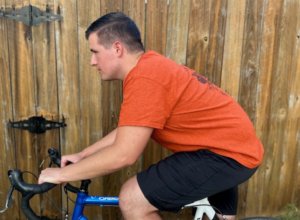By Ray Hayes, Regional Manager of Outpatient Therapy, Baptist Health Rehabilitation Institute-Little Rock.
Whether you’re a daily commuter, a weekend enthusiast, or a dedicated racer, we all know there’s nothing quite like the feeling of freedom that comes with riding a bike. But let’s face it, sometimes those rides can leave us feeling a bit worse for wear. Ray Hayes, regional manager of outpatient therapy at Baptist Health Rehabilitation Institute-Little Rock, shares some tips on how to optimize your ride and keep those pesky injuries at bay.
Proper Posture
Proper posture while cycling has an impact on performance and can help prevent overuse injuries. It is key to maintain neutral alignment of hips, neutral spine from the top of your head down to your hips, neutral shoulders, and keep your elbows in tight (avoiding forward shoulder blades). Additionally, It is also important to try to be relaxed while in this position. Sustained muscle tension can lead to fatigue or injury, and may impact your overall performance. See the following tips and exercises to prevent injuries.

Incorrect
- Forward shoulders
- Rounded spine
- Posterior tilted pelvis
- Elbows out wide

Correct
- Neutral shoulder
- Relatively straight spine
- Neutral pelvis
- Elbow in closer
Stretching
Previously we discussed the importance of stretching your psoas, hamstring and gastroc soleus complex. It is recommended to stretch after each cycling workout, holding each stretch for at least 30 seconds. Below are examples of how to stretch each muscle.
Hamstring Stretch
Take your leg and prop it up on a stool or on the floor in front of you. Make sure to keep your toe pointed up and your knee straight. Then, hinge forward at the hips while keeping your chest pressed out. Stop leaning forward when you feel the stretch on the backside of your thigh and behind the knee.
Gastroc-soleus Stretch
Stagger your stance to where you are in a lunge position. Keep the back leg straight with the heel on the ground. Lean into the lunge until you feel a slight stretch in the calf area.
Core Exercises
We also discussed the importance of core strength while riding a bike. Your core includes your abdominal and lower back muscles that create a brace for your core. It is important to strengthen both of these areas in order to create good stability and increase your efficiency while biking. You will want to start slow and build up your strength gradually to decrease risk of injury. You can find examples of various exercises below.
Marches
Lay on your back with your knees bent. Brace your core by trying to pull your belly button into the floor (you should have your back flat against the floor). While bracing, slowly lift one foot 3-6 inches off the floor. Slowly lower your foot back down and alternate with the other foot.
Straight Leg Raise
Lay on your back with one knee bent and the other leg straight. Brace your core by trying to pull your belly button into the floor (your back should be flat against the floor). While bracing, lift the straight leg up to the height of your bent knee and then slowly lower back down. Repeat on both legs.
Bridges
Lay on your back with both knees bent. Brace your core by trying to pull your belly button into the floor. Then, squeeze your bottom, push through your feet, and lift your hips up off the floor until you make a straight line from your knees to your shoulders. Do not arch your back at the top. Then, slowly lower back down.
Quadruped Alternating Leg Lift
Start on your hands and knee with a neutral spine (not humped or arched). Take a leg and kick it backwards while keeping your pelvis neutral. Make sure you are not rotating your pelvis up or down. Slowly put your leg back down and switch to the other side.

